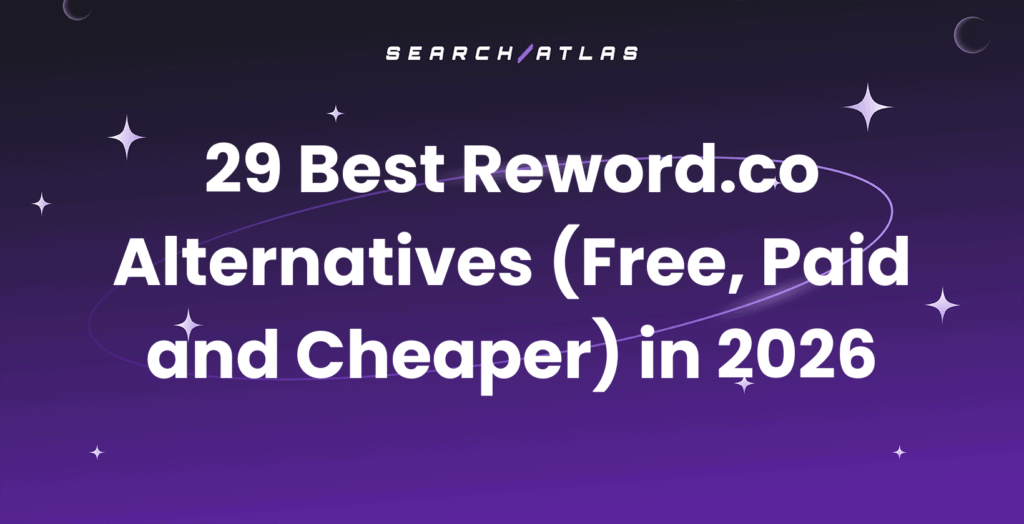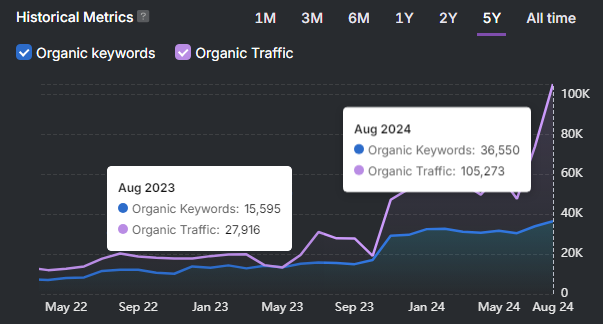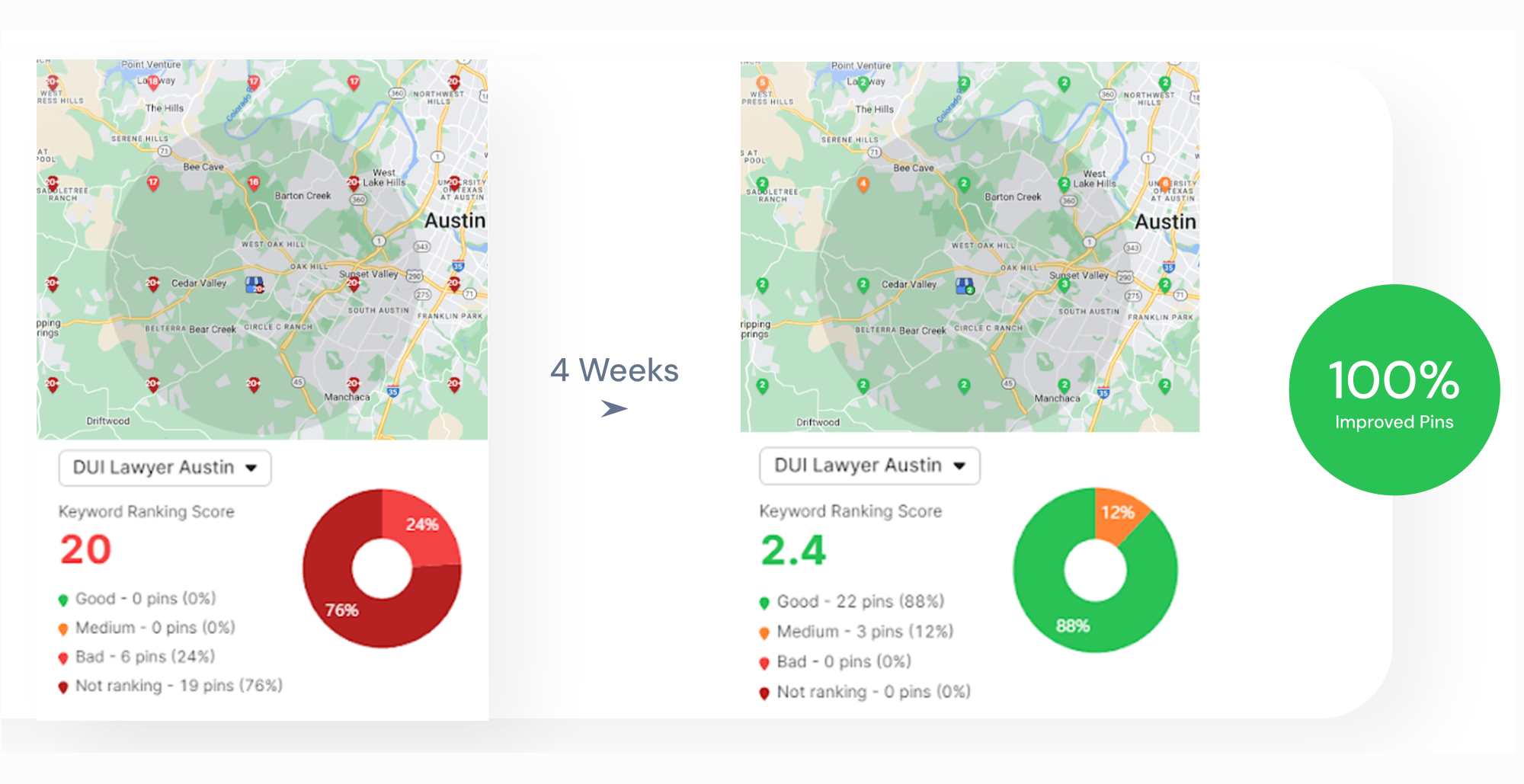Backlinks are links created when one website links to another. Backlinks are digital votes of confidence to search engine algorithms, as Google uses them to evaluate website authority, content credibility, and ranking potential. High-quality backlinks from relevant domains improve search visibility, while poor-quality links from unrelated sources can trigger Google penalties and harm rankings.
Website backlinks drive SEO success through multiple channels. Backlinks help search engines discover and index your content faster, provide direct referral traffic, and establish PageRank and topical authority in your industry. Effective backlink acquisition strategies include creating valuable content that naturally attracts links, building relationships with industry websites, guest blogging on relevant sites, fixing broken links, and reclaiming unlinked brand mentions.
What are Backlinks?
Backlinks are incoming hyperlinks from other websites to your web pages that serve as third-party endorsements, signaling your content’s credibility and value, or PageRank. Backlinks are called “incoming links” or “inbound links” because they lead users and search engine crawlers from other websites to your website to discover your content.
External links originating from high-authority, relevant domains are considered the most impactful for search visibility.
For example, a trusted digital marketing blog publishes an article about content strategies and links to your SEO tool. This creates a backlink to your website. The HTML code contains the visible anchor text reading “comprehensive SEO platform” that users can click to visit your site. When readers discover this backlink while reading about content marketing, they follow it to your page, creating a direct connection between related topics.
This relationship between websites builds backlink SEO strength, establishing a network of relevant references that strengthen your authority within your industry’s digital ecosystem.
How do Backlinks Work?
Backlinks work as digital pathways search engines follow to discover, evaluate, and rank web content. When another website links to your page, search engines interpret this connection as a vote of confidence in your content quality.
Google’s algorithms analyze backlinks to determine how pages should rank in search results. Backlinks help SEO by transferring authority from the linking site to yours, with links from high-quality, relevant websites providing substantially more ranking benefits than those from low-quality or unrelated sources.
Backlinks serve as a definitive ranking factor in Google’s algorithm, with the search engine confirming their importance in official documentation (and, as confirmed with a Google 2024 API leak, PageRank is still a factor). When a reputable website links to your content, it passes what SEO professionals call “link equity” or “link juice” – a portion of its authority that strengthens your position for related searches.
The backlink evaluation process involves analyzing multiple signals (including the linking site’s topical relevance), authority metrics, content context, and anchor text. A thorough backlinks assessment helps search engines determine how much ranking value each backlink provides to your domain authority.
Backlink analysis and acquisition must align with your topical map and target content hierarchy. High-authority backlinks should point to cornerstone pages or content hubs, boosting overall domain authority and allowing internal links to distribute that authority deeper into the site.
What is a Backlink Authority?
Backlink authority measures the ranking power a link passes to your website based on the credibility, trustworthiness, and relevance of the linking domain. Backlink authority quantifies how much each individual backlink contributes to improving your search positions. Backlink authority varies greatly between sources, with links from established, trusted websites providing substantially more value than those from new, low-traffic, or unrelated domains.
Google determines backlink authority through complex algorithms that evaluate numerous signals about the linking website. Backlink signals include the site’s age, content quality, expertise demonstration, user engagement metrics, and backlink profile. The concept derives from PageRank, the revolutionary algorithm that assesses websites based on the quantity and quality of their incoming links. While Google no longer publicly shares PageRank scores, the fundamental principle of authority transmission through links remains central to search rankings.
Search Atlas evaluates backlink strength through its Domain Power metric, providing standardized measurements that help prioritize link-building opportunities. Domain Power blends organic traffic and ranking keywords to create a reliable authority indicator that reflects Google’s current evaluation methods.
Unlike traditional metrics that rely heavily on backlink counts, Domain Power uses real-world performance data to assess a site’s true value. This prevents manipulation through link farms or spam networks, confirming that you identify genuinely valuable linking opportunities. A high Domain Power score indicates a website has quality backlinks AND real authority through organic visibility and ranking positions.
What is the Importance of Backlinks in SEO?
Backlinks are important in SEO because they are trust signals that directly influence how websites rank in search results. Backlinks function as digital votes of confidence from other websites, showing search engines that others value your content enough to reference it. Backlink SEO forms a critical part of off-page optimization and is inseparable from content strategy. The strongest backlinks are those that vouch for your content’s value and topical fit.
Backlinks provide multiple ranking benefits for websites. Incoming links help search engines discover and index your content faster, bring direct referral traffic from users clicking through, and establish your site’s expertise within specific topics. Strong backlinks create a protective network that helps maintain rankings during algorithm updates by demonstrating broad industry recognition of your content value.
Backlinking connects your website to the broader web ecosystem in ways that search engines recognize and reward. Websites with quality backlink profiles consistently outrank competitors with similar content but fewer external endorsements. For competitive keywords where many sites offer similar information, backlinks often determine which pages appear in top positions. This fundamental connection between SEO and backlinks makes strategic link acquisition elementary for any website seeking sustainable search visibility and traffic growth.
What are the Main Types of Backlinks?
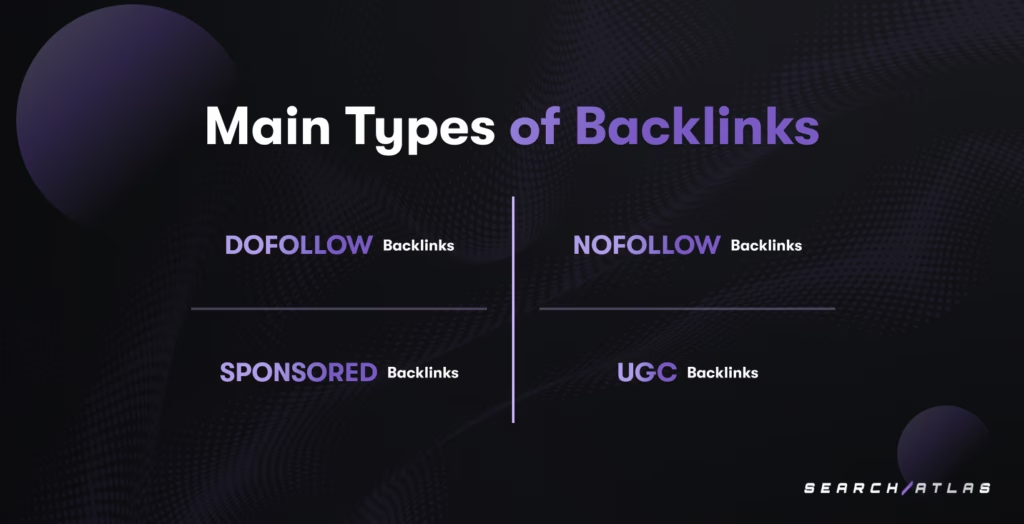
Backlinks exist in several distinct varieties, each carrying different SEO values based on technical attributes, placement context, and acquisition methods.
The main types of backlinks are dofollow backlinks, nofollow backlinks, sponsored backlinks, and UGC backlinks.
- Dofollow Backlinks. Dofollow backlinks are standard hyperlinks that pass full authority and ranking power to the destination website. Dofollow represents the default link state in HTML without additional attributes. These links allow search engines to follow the connection between sites and transfer link equity that strengthens domain authority. Dofollow backlinks provide maximum SEO benefits for improving search rankings.
- Nofollow Backlinks. Nofollow backlinks are hyperlinks containing the rel=”nofollow” attribute that instruct search engines not to transfer authority through the connection. While traditionally providing limited direct ranking benefits, Google now treats nofollow attributes as “hints”, not really absolute directives. Nofollow backlinks contribute to creating natural link profiles and drive referral traffic despite their reduced SEO impact.
- Sponsored Backlinks. Sponsored backlinks are links marked with the rel=”sponsored” attribute identifying paid placements or advertisements. Introduced by Google to provide more nuanced link classification, this attribute helps search engines distinguish between editorial endorsements and commercial relationships. Using this attribute for paid links maintains transparency and helps avoid potential penalties.
- UGC Backlinks. UGC backlinks are links containing the rel=”ugc” attribute identifying user-generated content sources such as forum posts, comments, or social media references. This attribute helps search engines understand links created by site users rather than editorial decisions by site owners. UGC backlinks typically carry less authority than editorial links but contribute to diverse link profiles.
How to Get High-Quality Backlinks for SEO?
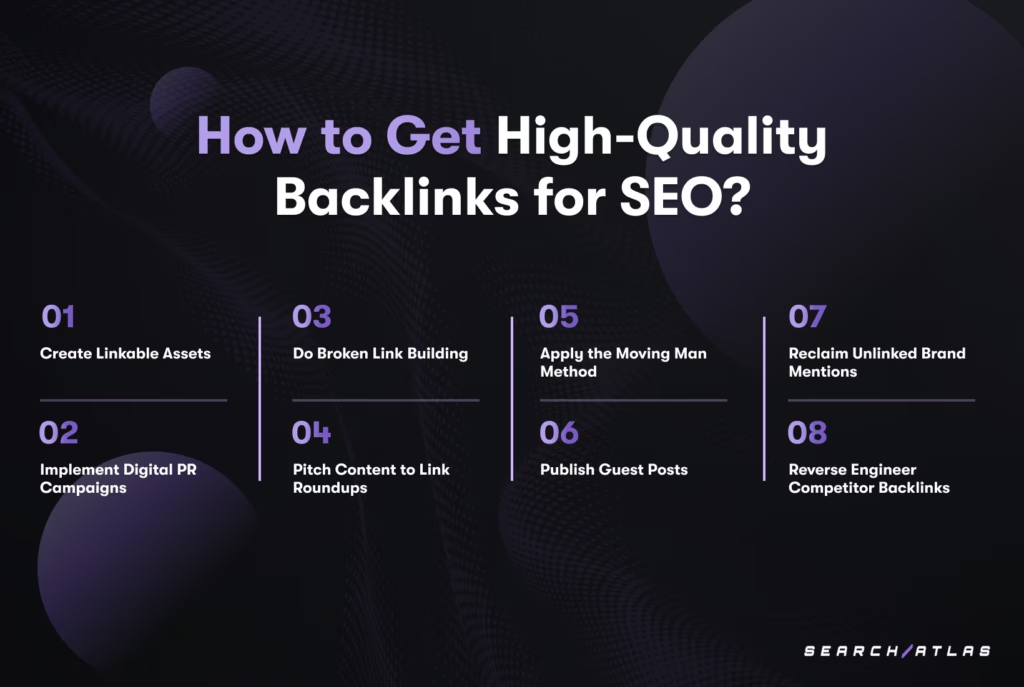
Getting high-quality backlinks for SEO requires strategies focused on creating real value instead of using manipulative tactics. SEO professionals must focus on quality, context, and topical alignment. High-quality backlinks come from real websites, are editorially placed, and align with the user’s informational or commercial journey.
The top strategies for building high-quality backlinks are listed below.
1. Create Linkable Assets That Naturally Earn Backlinks
Creating linkable assets focuses on developing unique, authoritative content that solves specific problems, answers important questions, or provides insights unavailable elsewhere. Linkable assets are resources that offer exceptional value and attract backlinks naturally.
Different types of linkable assets work for different verticals, content budgets, and outreach strategies. The most effective formats that consistently earn backlinks are below.
- Infographics, GIFographics, and Visual Explainers. Infographics, GIFographics, and visual explainers remain top-performing formats for link acquisition when used correctly. Infographics and visual content work best when summarizing complex data visually, highlighting geographic or categorical comparisons (e.g., “map-o-graphics”), or targeting publishers that regularly feature graphics.
- Online Tools and Calculators. Interactive tools, widgets, and calculators are among the most powerful linkable assets because they solve a specific problem (e.g., ABV calculator) and reduce cognitive load or manual calculations.
- Industry Awards and Rankings. Awards, rankings, and curated lists create ego bait for influencers, brands, and businesses. Recipients are flattered and more likely to share and link, and fans and readers of awardees amplify reach and visibility.
- Data-Driven Studies and Research. Studies based on original or aggregated data are highly cited across industries. Studies offer evidence to support existing claims, and journalists and bloggers rely on them for reference material.
- Definitive Guides and Tutorials. Definitive guides and tutorials that cover a topic in depth are highly shareable and reference-worthy. Comprehensive, step-by-step guides consolidate fragmented knowledge into one authoritative page and serve as go-to resources for beginners and practitioners.
- Coined Unique Terms or Frameworks. Coined terms, when accepted by the industry, can create massive link velocity. They become reference points in discussion (e.g., “skyscraper technique”) and create brand association and intellectual property.
Linkable assets do not earn backlinks by chance. Linked assets succeed when supported by a structured promotion strategy that includes manual outreach to relevant publishers and blogs, content amplification via social and PPC channels, internal linking to give them initial crawlability and authority, email marketing to your subscriber base, press mentions, and newsletter features.

2. Implement Digital PR Campaigns
Digital PR (Public Relations) campaigns use newsworthy content to earn media coverage and authoritative backlinks from high-profile publications. Digital PR adapts traditional public relations for the web, focusing specifically on creating stories and assets that journalists want to cover while including links to your website. Digital PR generates powerful editorial backlinks that carry substantial domain authority and topical relevance.
Successful digital PR campaigns begin with creating genuinely newsworthy content based on original research, data analysis, expert interviews, or unique perspectives on trending topics. This can include controversial rankings or trend pieces, reactive campaigns tied to news cycles (“newsjacking”), or expert commentary timed to seasonal or trending topics.
Digital PR content must provide real news value or insights that publications want to share with their audiences. Once developed, targeted outreach to relevant journalists and media outlets introduces your content to potential linking sources in a personalized, value-focused manner.
Search Atlas Digital PR Tool streamlines the digital PR campaign process by identifying journalists and publications most likely to cover your specific content. Search Atlas Digital PR Outreach Tools allow you to automatically find and reach out to bloggers, editors, and publishers, and prioritize outreach toward the most promising opportunities.
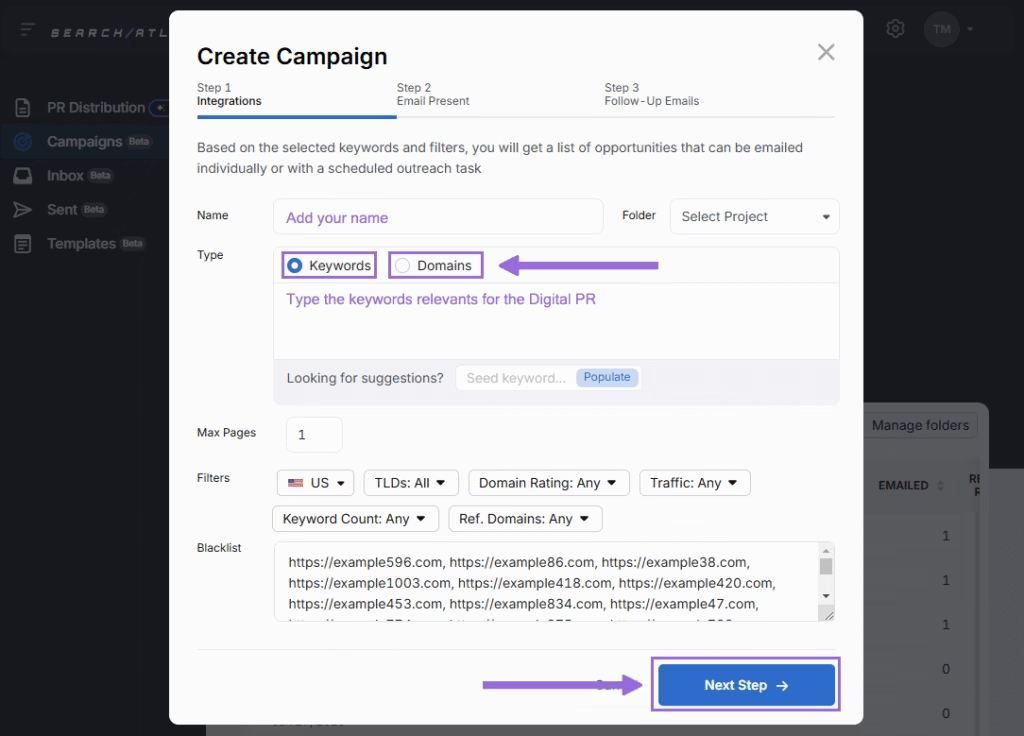
Focusing on publications aligned with your content themes increases the likelihood of earning valuable media backlinks that significantly boost your domain authority.
3. Build Backlinks via Broken Link Building
Broken link building identifies dead links on relevant websites and suggests your content as a replacement. Broken link building works particularly well because it solves a problem for webmasters rather than requesting a favor. Helping site owners fix broken links that harm user experience (UX) creates a mutually beneficial scenario that increases link acquisition success rates.
Use tools like the Search Atlas Site Audit Tool to identify broken external links on relevant industry websites. Enter target websites in the Search Atlas Site Audit Tool, run analysis, and review the Issues section to find broken links that represent replacement opportunities.
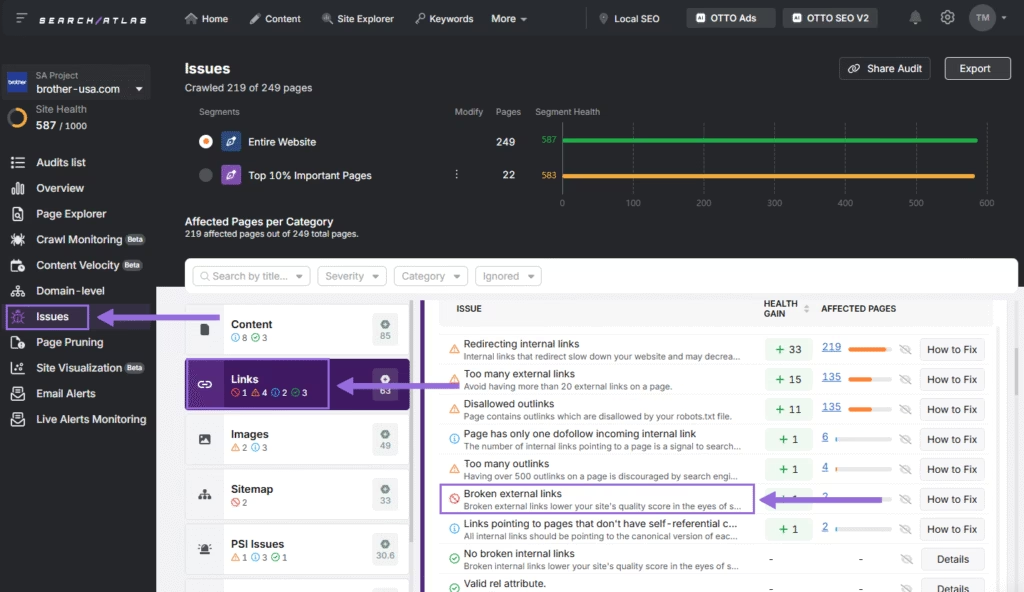
Focus on resource pages, guides, and educational content that typically contain numerous outbound links to industry resources.
After identifying broken links, develop or adapt existing content as suitable replacements that match the original link’s topic and purpose. When contacting site owners, highlight the broken link you found, explain how it impacts their user experience, and offer your resource as a ready-made solution.
4. Pitch Content to Link Roundups and Curated Lists
Link roundups are periodic (daily, weekly, or monthly) content collections that highlight quality resources. Link roundups and curated lists gather valuable resources, tools, and articles to provide readers with industry updates.
Pitching content to link roundups and curated lists is ideal for promoting new blog posts or data-driven articles, earning backlinks from niche editorial content, and expanding topical authority.
To find relevant link roundups, use search operators like “keyword” + “link roundup”, inurl:roundup “keyword” + “this week”, intitle:roundup “keyword” + “best of” and similar variations.
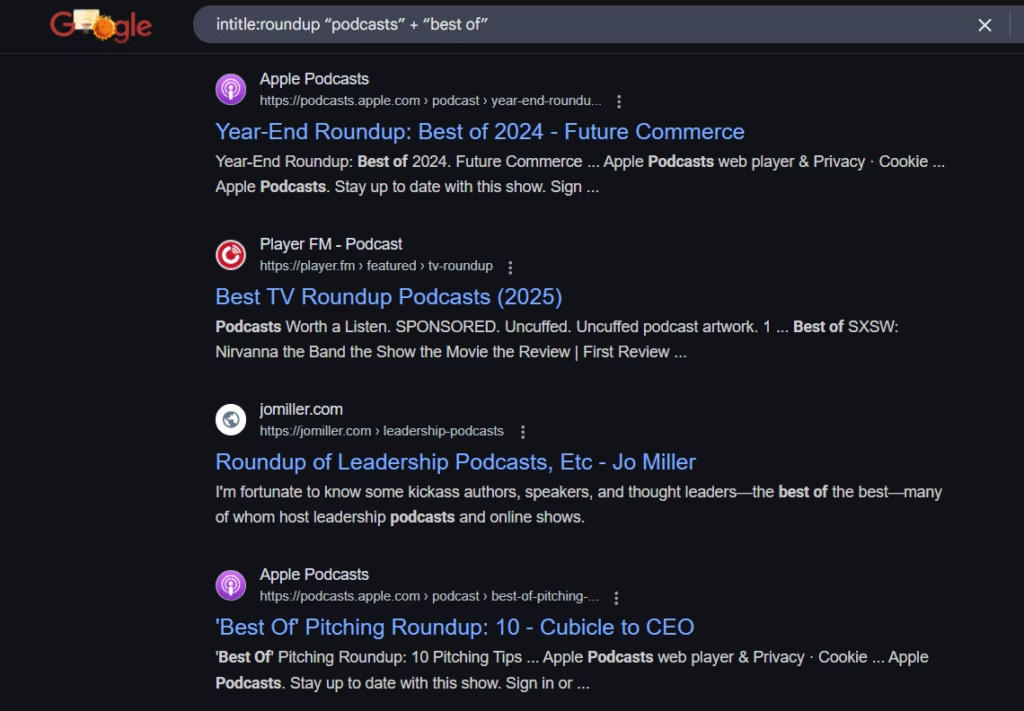
Using or omitting quotation marks in your search can alter the results. If you’re not getting the outcome you expected, try adjusting your use of quotation marks.
It’s wise to filter for recently updated roundup blogs. Click on Tools, then set the timeframe to something recent, typically within the last 1–3 months, for the most relevant results.
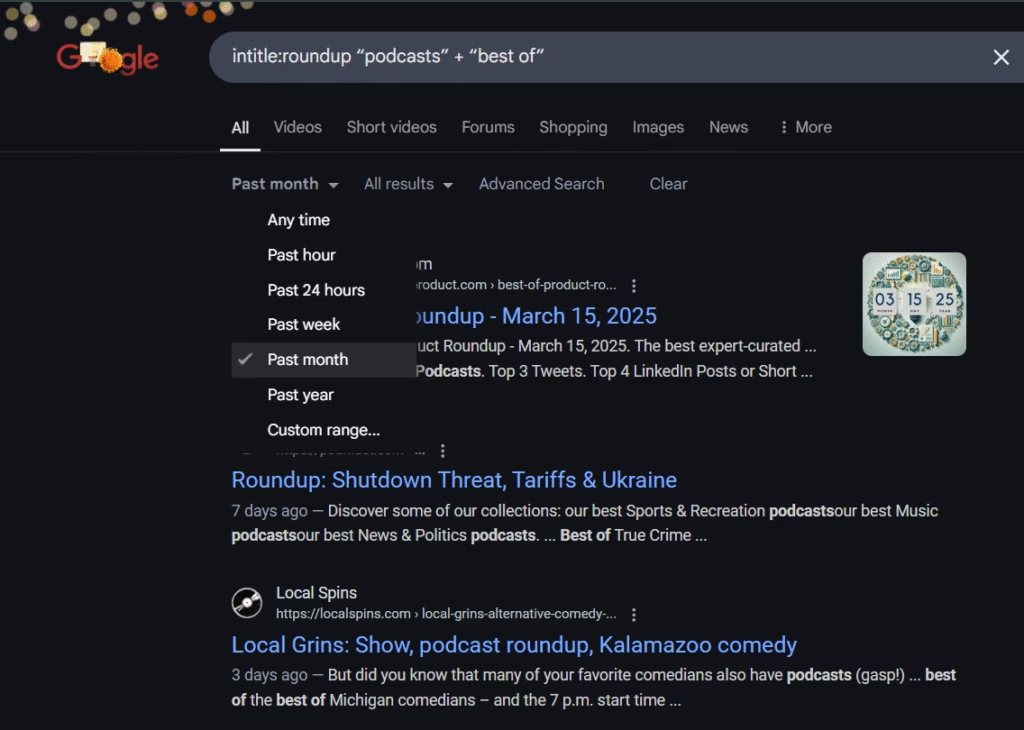
5. Apply the Moving Man Method to Outdated Link Sources
The Moving Man method targets websites, resources, or businesses that have changed names, rebranded, shut down, or become outdated. The Moving Man method involves finding sites that are still linking to these outdated resources and suggesting your content as a relevant replacement.
To implement the Moving Man method, first identify web pages or resources in your industry that are no longer available or have moved to a new URL. Look for businesses that have rebranded, popular tools that have shut down, or once-popular resources that haven’t been updated in years.
Once identified, use the Search Atlas Backlink Research Tool to discover which websites are still linking to these outdated resources, creating a targeted list of outreach opportunities.
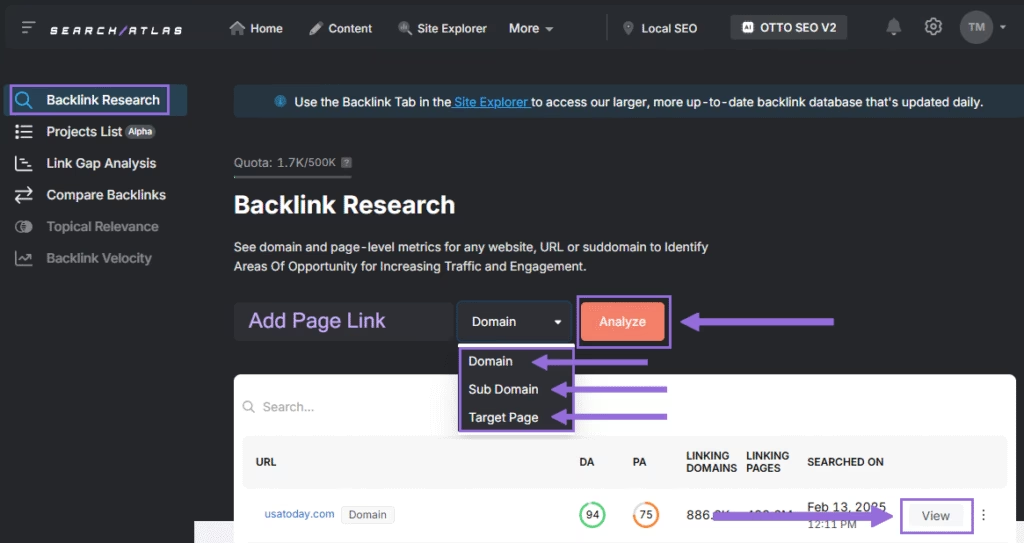
When reaching out to site owners, provide specific information about the outdated link on their site, including its exact location and a screenshot if possible. Explain why the resource is no longer relevant or functional, and suggest your content as a valuable alternative that would benefit their readers. The Moving Man method earns editorial links by improving UX for their readers.
6. Publish Guest Posts on Topically Relevant Blogs
Guest blogging refers to creating content for external websites in exchange for author attribution that includes backlinks to your site. Publishing guest posts on topically relevant blogs is still effective when targeted and strategic.
For publishing guest posts, choose niche-specific blogs with real traffic and offer useful, non-promotional content, and include one or two contextual dofollow links.
Research each publication’s content style, topics, and guidelines before pitching personalized ideas that provide genuine value to their readers rather than thinly disguised promotional content. Focus on quality over quantity by prioritizing reputable sites with engaged audiences rather than pursuing volume through low-quality blogs.
Search Atlas Content Genius Tool streamlines the guest posting process by helping create high-quality content tailored to each publication’s standards. The Search Atlas Content Genius Tool analyzes top-performing content on target websites, identifying preferred formats, topics, and writing styles to increase acceptance rates.
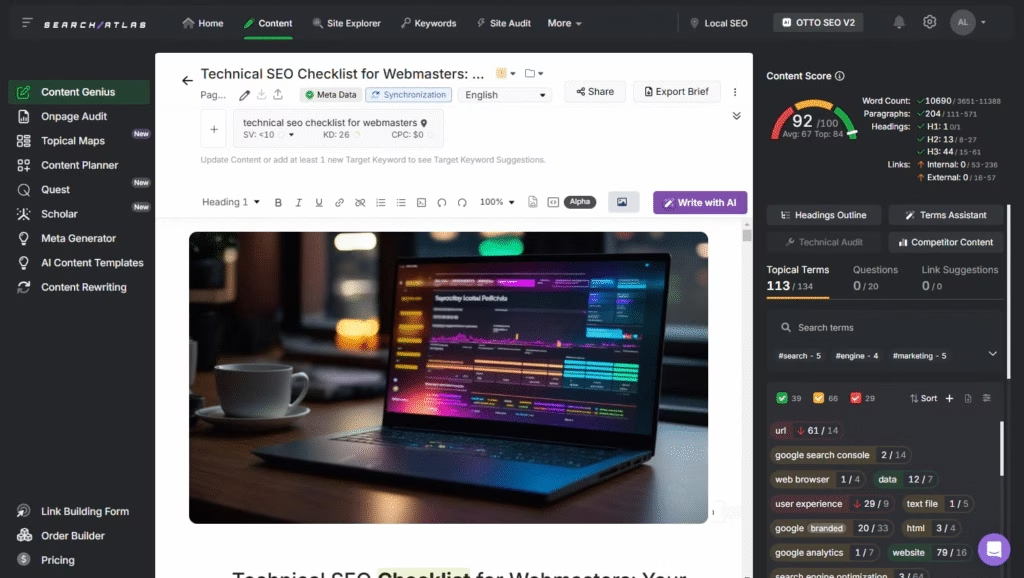
With AI-powered content creation capabilities that the Search Atlas Content Genius Tool offers, you can quickly produce draft posts that match publication requirements while maintaining the quality standards necessary for successful guest blogging opportunities.
7. Reclaim Unlinked Brand Mentions for Link Equity
Reclaiming unlinked brand mentions for link equity identifies instances where websites mention your brand, products, or services without linking to your site.
Brand mention reclamation builds on existing awareness of your brand, making it one of the most straightforward link building techniques with high success rates. Reclaiming unlinked mentions allows you to capitalize on the recognition you’ve already earned while improving your backlink profile.
To find unlinked brand mentions, set up Google Alerts to receive notifications whenever your brand appears online.

Once mentions are identified, evaluate each for context, sentiment, and the authority of the mentioning website to prioritize outreach efforts. Focus on positive, contextually relevant mentions on authoritative sites for the highest link value and conversion potential.
8. Reverse Engineer Competitor Backlinks for Target Discovery
Reverse engineering competitor backlinks is one of the most efficient ways to discover high-potential linking opportunities within your niche. Instead of starting from scratch, reverse engineering competitor backlinks allows you to tap into link sources that are already proven to work for websites targeting the same keywords or topics as yours.
The process of reverse engineering competitor backlinks involves four steps. The steps are listed below.
- Identifying top-performing competitor content that ranks for your target keywords;
- Analyzing competitor backlink profiles to uncover referring domains;
- Filtering for quality and relevance, focusing on editorial backlinks from unique domains;
- Outreaching to these sources with an improved, more current, or complementary resource.
You can use the Search Atlas Link Gap Analysis Tool to identify the backlink gap between your website and competitors. The Search Atlas Link Gap Analysis Tool provides you with a list of websites, their Domain Authority scores, spam scores, and the top linking page for each competitor.
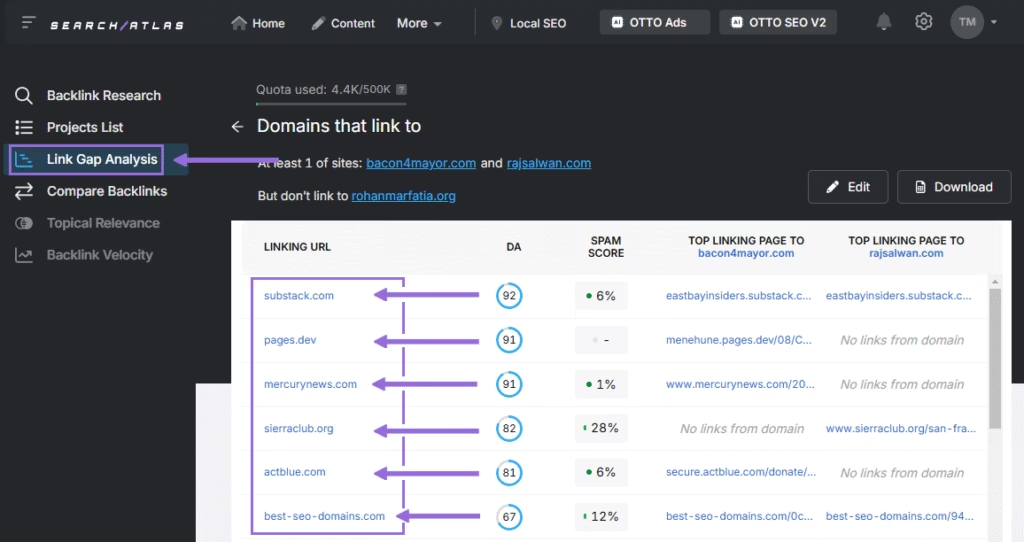
There is no set number of backlinks that guarantees rankings. The number of backlinks you need depends on the competition level of your keyword, the quality and authority of referring domains, the topical relevance of your backlink source, and your domain’s existing authority and backlink profile.
To estimate how many backlinks you need, analyze the top-ranking pages for your target keyword and count their referring domains (not just raw backlink totals).
Earning 10 contextual backlinks from different authoritative domains is better than 100 spammy or duplicated ones. Prioritize quality, domain diversity, and topical relevance.
Where to Find Easy Backlinks?
Easy backlinks refer to low-effort, low-barrier link opportunities that can be acquired without advanced outreach, technical execution, or high-level content development. Easy backlinks typically include backlinks from directories, forums, profiles, and brand-controlled assets.
The main ways to find easy backlinks are listed below.
1. Submit your site to authoritative business directories. Submit your site to directories like Google Business Profile, Yelp, Bing Places, and Apple Maps. Niche directories (e.g., TripAdvisor, Clutch, or industry-specific aggregators) count.
Submitting your site to directories supports SEO by signaling NAP consistency, citation trust, and domain diversification, which help search engines evaluate your site’s entity credibility and local authority.
2. Create brand profiles on high-authority platforms. Build a presence on sites like Crunchbase, Medium, About.me, SlideShare, and Behance. Many allow you to link to your website from your profile bio or description.
Creating brand profiles supports SEO by signaling online presence, brand entity connections, and passive link building, which help search engines evaluate your business’s legitimacy and topical footprint.
3. Contribute to industry forums with signature links. Join discussions on platforms like Reddit, Quora, or Stack Exchange, and link to your site contextually or in your profile signature, if permitted. Identify industry blogs that allow website fields when leaving comments. Focus on adding value through insightful replies, not spam.
Contributing to industry forums supports SEO by signaling topical engagement, brand expertise, and relevance, which help search engines evaluate your authority within niche communities.
4. Comment on blogs that allow URL entries. Find blogs that use a Name + Website comment structure (not just Disqus or FB plugins). Leave meaningful comments that link back to your site. Avoid low-quality spam commenting and focus on authority blogs with moderation.
Commenting on blogs supports SEO by signaling niche presence, human engagement, and domain-level diversity, which help search engines recognize your site as active in your topical ecosystem.
5. Submit content to aggregators and syndication platforms. Use websites like Scoop.it, AllTop, and GrowthHackers that allow manual or automated link submissions to help seed early visibility and indexing.
Submitting to aggregators supports SEO by signaling content distribution, early indexation, and co-citation potential, which helps search engines crawl and categorize your content faster.
6. Get supplier or partner backlink opportunities. Ask for a link from your vendors, SaaS providers, or partners under “Clients,” “Partners,” or “Featured On” pages. Supplier or partner backlink opportunities often allow dofollow backlinks with brand anchors.
Getting listed on partner pages supports SEO by signaling third-party trust, commercial association, and homepage-level backlinks, which help search engines evaluate your site’s real-world credibility.
How to Check Backlinks of a Website?
Checking backlinks provides the must-needed insights into a website’s link profile. Backlink SEO analysis is foundational to identifying toxic links, evaluating competitor strategies, and uncovering missed opportunities for link acquisition.
You can check backlinks using Google Search and Google Search Console, or advanced SEO tools like the Search Atlas backlinks tools. The steps to check the backlinks of any website are listed below.
- Use Google Search Operators to find basic backlinks. Enter “link:yourdomain.com -site:yourdomain.com” in Google’s search bar for a limited sample of backlinks. While Google no longer fully supports this operator, it can provide some initial results. You can try “site.com” to see pages indexed from that domain.
- Check Google Search Console for verified backlink data. Access the Links report under the Links section of Google Search Console (GSC) to view top linking sites, most linked pages, and anchor text distribution. This data comes directly from Google but only shows backlinks to sites you own and have verified.
- Analyze complete backlink profiles with the Search Atlas Site Explorer Tool. Enter the domain you want to analyze to reveal metrics on backlink quantity, quality, and trends. The Search Atlas Site Explorer Tool offers the Backlinks section that provides detailed information about the domain authority of linking sites, dofollow vs. nofollow distribution, and anchor text patterns.
- Compare competitive backlink profiles using Search Atlas Link Gap Analysis. Use the Search Atlas Link Gap Analysis Tool to highlight valuable domains linking to competitors but not to your site, creating a targeted prospecting list. Identify competitors’ unique link sources and prioritize them based on authority and relevance for your outreach campaigns.
- Monitor backlink acquisition and loss over time. Set up regular backlink reports or alerts to track new links, lost links, and changes in your overall backlink profile.
- Export backlink data for deeper analysis and outreach planning. Download detailed reports from Search Atlas to organize link opportunities, prepare outreach campaigns, and track progress toward link building goals.
The Backlinks section of the Search Atlas Site Explorer Tool offers all the necessary insights for checking backlinks of a website.
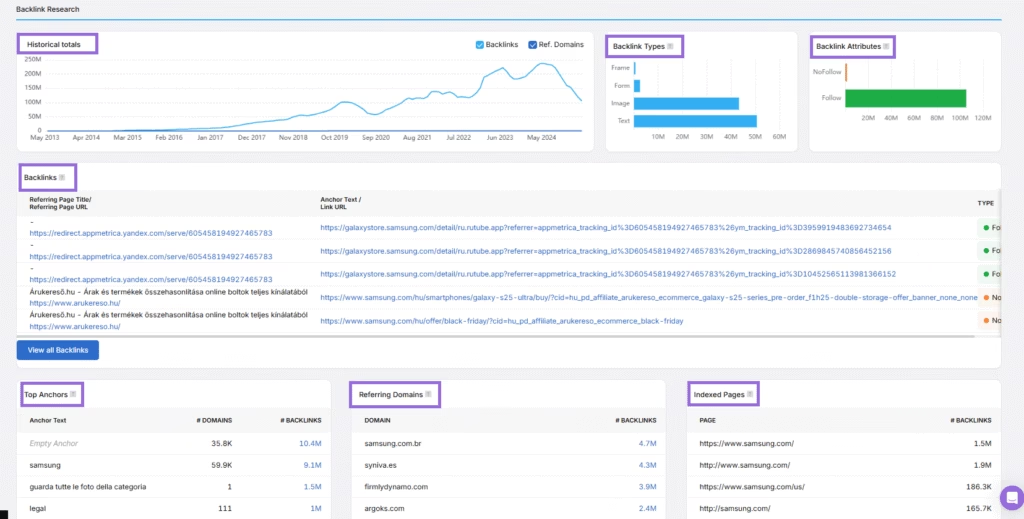
What are the Best Backlink Checker Tools?
The best backlink checker tools are specialized SEO solutions that allow marketers to analyze, monitor, and optimize their backlink profiles by evaluating link quality, authority, diversity, and relevance. The best backlink checker tools uncover insights into link-building effectiveness, identify toxic or spammy backlinks, and reveal competitive gaps in off-page SEO strategies.
Backlink analysis is a must for any off-page SEO campaign, as it directly influences your website’s authority, trust signals, and ranking performance. The right backlink tools display existing backlinks and highlight lost links, referring domains, anchor text patterns, and growth trends over time.
The best backlink checker tools include free options from Google, such as Google Search Console, and advanced SEO platforms like Search Atlas, which offer AI-powered insights and competitive intelligence. These backlink checker tools provide varying levels of backlink data, ranging from link origin and anchor usage to authority scores and domain diversity.
The best backlink checker tools are listed below.
Google Search Console (GSC) is the foundational backlink monitoring tool. GSC provides verified backlink data directly from Google, displaying linking pages, referring domains, and anchor texts. Its Links report helps identify your most linked content and track new or lost backlinks. While limited in scope, it remains a trusted, first-party source for understanding which backlinks Google recognizes and values.
Search Operators in Google Search are useful for manual backlink research. Operators like link:example.com or “brand name” -site:example.com help uncover brand mentions and backlink opportunities not shown in GSC. While not scalable, they are helpful for quick spot checks, brand audits, and citation discovery.
Search Atlas SEO Software Platform offers a comprehensive backlink intelligence suite powered by real-time crawling and AI-driven analysis. The Search Atlas Site Explorer Tool reveals backlink totals, referring domains, link types (follow/nofollow), anchor distribution, and Domain Power, Search Atlas’ proprietary authority metric that correlates more closely with Google rankings than legacy metrics like DA or DR. Site Explorer supports exportable reports and historical backlink tracking for performance benchmarking.
Search Atlas Backlink Gap Analysis Tool identifies linking domains your competitors have earned but you haven’t. Analyzing overlap across multiple competitors surfaces high-value domains where outreach can be focused. Results are filterable by authority, trust flow, and relevance to streamline prospecting.
Search Atlas Backlink Profile Comparison Tool allows you to compare your link profile with up to six competitor websites. The Search Atlas Backlink Profile Comparison Tool displays side-by-side metrics such as Domain Power, Page Authority, total referring domains, anchor usage, and link types. This feature helps uncover strategic gaps and measure how your backlink strategy stacks up in your niche.
Search Atlas WILDFIRE (Websites Inter-Linking Directly Fostering Influence, Reputation and Engagement) is Search Atlas’s proprietary link-building engine that helps you earn high-quality backlinks through a 2:1 exchange system. You add two outbound links to authoritative, topically relevant sites and receive one backlink in return. WILDFIRE uses AI-powered matching to ensure all links are contextually aligned and meet Domain Power criteria. You get 10 new backlink opportunities weekly, with full control to approve or deny each one. Approved links are placed in the HTML footer (hidden from users but visible to search engines), ensuring crawlability without affecting UX. WILDFIRE is a fast, scalable, and reputation-safe way to grow your backlink profile.
Together, Google’s native tools and Search Atlas backlink analysis tools form a complete backlink monitoring and optimization ecosystem that addresses fundamental and advanced aspects of link profile management and growth.
When Should I Disavow Backlinks?
Disavowing backlinks becomes necessary when your site accumulates harmful links that could trigger search engine penalties or algorithmic filtering. Disavowing backlinks tells search engines to ignore specific backlinks when assessing your site, removing their negative impact from your link profile evaluation.
You should consider disavowing backlinks when clear patterns of unnatural or manipulative links appear in your profile. Signs requiring action include sudden spikes in low-quality links from irrelevant websites, links from known link schemes or private blog networks (PBNs) and exact-match anchor text patterns that appear manipulative. Additionally, receiving a manual penalty notification in Google Search Console with specific examples of problematic links represents a clear signal to implement disavow actions.
The disavow process requires careful analysis to avoid mistakenly removing valuable links. Begin by conducting a full backlink audit using the Search Atlas backlink tools to identify potentially harmful links based on quality metrics, relevance, and unnatural patterns. After identifying problematic links, attempt outreach to webmasters requesting link removal before proceeding to disavow as a last resort for links that cannot be removed directly.
To disavow backlinks, create a properly formatted text file listing domains or specific URLs to be disavowed, then submit this file through Google’s Disavow Links tool in Google Search Console.
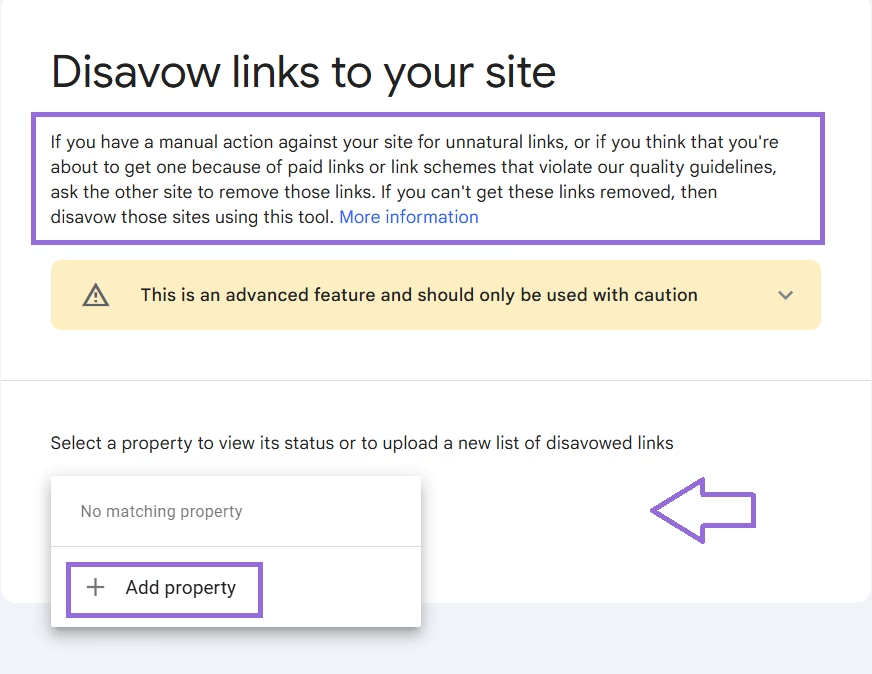
Monitor your site’s performance following disavow submission, recognizing that results typically take several weeks as search engines recrawl affected pages and reprocess your link profile without the disavowed connections.
Is It Safe to Buy Backlinks?
No, it is not safe to buy backlinks if you’re referring to paid link schemes that violate Google’s Webmaster Guidelines. Manipulative tactics for buying backlinks, such as paying for links from private blog networks (PBNs), low-quality directories, or spammy sites, trigger algorithmic penalties or manual actions that tank your site’s rankings and credibility.
However, the answer becomes more nuanced when distinguishing between black-hat link buying and investing in high-quality backlinks through legitimate means.
For instance, some businesses use “link placement services” or “content partnerships” that involve payments. but these links are editorially placed on authoritative, relevant sites, disclosed as sponsored when needed, and deliver actual value to the reader. While Google still officially discourages this, it’s a common practice in the SEO industry and much harder for search engines to detect or penalize, especially when done transparently and strategically.
On the other hand, investing in high-quality backlinks through reputable content marketing, digital PR, or guest posting is a safer and more effective strategy, even if it requires a budget. The key distinction is editorial relevance and transparency when you buy backlinks, not automation or scale.
If you’re looking to buy high-quality backlinks, work only with vetted platforms that prioritize real content, topic alignment, and editorial review. ver prioritize link quantity over quality or relevancy.
What to Know About Backlinks Besides Link Building?
Backlinks are incoming links from one website to another that serve as votes of confidence and authority, while link building is the strategic process of acquiring these backlinks through outreach and content creation.
The temporal aspects of backlink evaluation by search engines demonstrate the importance of consistent, natural link acquisition patterns rather than sudden spikes or irregular activity. Search algorithms increasingly evaluate link velocity (the rate and pattern of link acquisition), alongside traditional metrics like quantity and authority. This emphasis on natural growth patterns reinforces the importance of sustainable, ongoing link building rather than intensive short-term campaigns that create unnatural acquisition signatures.
What to Know About Backlinks Besides PageRank?
Backlinks are vital connection points between websites that establish topical relevance and authority, while PageRank is the original Google algorithm that evaluated a page’s importance based on the quantity and quality of links pointing to it.
Backlinks contribute to search rankings through multiple signals beyond raw PageRank calculations, including topical relevance, anchor text context, and user engagement metrics from referral traffic. Modern search algorithms evaluate backlinks within sophisticated contextual frameworks that consider the linking site’s authority, the contextual relevance of surrounding content, and the overall linking patterns within specific topic clusters.
What is the Difference between Backlinks and Referring Domains?
Backlinks are individual hyperlinks from one website to another, while referring domains represent the unique websites from which those backlinks originate. For example, if a site links to your page five times, that equals five backlinks but only one referring domain.
Understanding the difference between backlinks and referring domains lets you accurately assess link building progress and competitive position while avoiding misinterpretation of backlink data.
The goal of tracking backlinks is to measure the volume and placement of link equity, anchor usage, and linking patterns. On the other hand, tracking referring domains focuses on diversity and authority. Google values multiple links from different high-authority sources more than numerous links from a single domain. In SEO, a healthy backlink profile balances a high number of unique referring domains with contextual, authoritative backlinks.
What is the Difference between Backlinks and Inbound Links?
Backlinks are hyperlinks created on external websites that point to your site, while “inbound links” is simply an alternative term used to describe the same linking relationship from the perspective of the destination site.
Backlinks and inbound links share identical technical properties and SEO benefits, as both terms describe external links directing users and search engines to your website. The terminology difference reflects industry vocabulary preferences rather than any functional distinction, with SEO professionals using both terms interchangeably when discussing external linking strategies and metrics.


